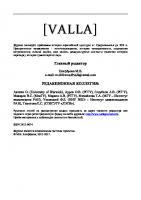Omushangelo 3: Oshikwanyama Orthography 3 9991605142
Windhoek: Gamsberg Macmillan, 2004. - VI, 44 p.- ISBN: 99916-0-514-2The complete guide of the newest orthography of Oshi
361 42 11MB
English Pages [51] Year 2004
Recommend Papers
File loading please wait...
Citation preview
OSHIKWANYAMA OMUSHANGELO3 ORTHOGRAPHY 3
Gamsberg Macmillan
IV
Foreword This edition of the oshikwanyama orthography 3 comes 2g years after the second revised edition, I(wanyama orthography 2 of 19g0 ty th" Native Language Bureau of the Department of National Education. The first I{wanyama orthography was published approximately thirty fìve years ago (1968), by the Native Language Bureau oi the then Department of Banru Education in collabotation with the I{wanyamu Lurrgrrrge committee and the Native Language Board of the then South \X/est Africa. It was attempted in this version to revisit cerrain inconsistencies in speÌÌìng and linguistic terminology as welÌ as to make it, where possible, ,rr"r_ friendly without sacrificing the quality of the edition. punctuation -orË marks that were not included in previous orthogtaphies, are incruded in this one. The inclusion of a word Ìist and an expraoadãn of úe pronunciation of the Oshikwanyama speech sounds adds to the practical vatue of this orthography, e_speciaÌÌyfor non-speakers of oshikwanyama who might show intelest in the language. The major change in the oshikw'.Íìyao'^ orthography 3 is that for the fìrst time in the histoty of its language development, tÀe oshikwanyama verslon of the orthography is included. This is a significant step in rhe enhancemenr of the starus and role of úe language âmongst its speakers as wel as in the multilingual set-up in which we co-exist. Furthermore, it wil contribute to a better understanding of the language rules by teachers and users of the language. Another alteration is that the officiar name of the language (Oshikwanyama), is used in the title of its orthography. Oshikwanyama Orthography 3 is the soÌe official orthography for Oshikwanyama and thus replaces all former orthographies. The revision which started in 199g, was finarised by the oshikwanyama Curriculum Committee tn the year 2004.
vi
Map of Namibia with thirteen Political Regions and neighbouring countries ./.-çr
OSHANA
.-.-, -.-.J.-.-.*--.--
a
\..
AtYoolA
zAr,BrA
ffifi;";"ru::È;iirr''''7
ïr"r*
Jà-
zIItBlowE
J
I
o.to,o'*oth.i
oMAHEKE i _. J f KHOTúAS a
rorswnryA
I I
ne'noap
i
i*i t\ t\
KARAS
/
.r'-. i !-.*.-.-..,."-rJ SOUÌH AER',CA
(Source: Lazatus Hangula,
1993, International
Windhqek: Note:
Mote people speak Oshikwanyma Few people speak Oshikwanyama IntetnationaÌ
Gamsberg
in these regions in these regions
boundaty
Regionalboundary ^.\.rv
vlll
Boundaty
Macmillan)
'
of Namibia.
This oshikwàÍyama orthography 3, was revised by the members of the curriculum committees for oshikwanyama for the years 199g to 2001 and 2001 to 2004. The Oshikwanyama Orthography 2, was compiÌed by Il Zimmetmann and G.S. Taapopi of the Native Language Buieau of the Department of NationaÌ Education in coÌlaborationwiú úe oshikwanyama LanguageCommittee and the Native Langmge Board. 1. Compiled by: Zimmermann \Xl Taapopi G.S. 2.
Revised by the members of the Curriculum Committees for Oshikwanyama: 2.1 Members of the Curiculum Committee for Oshikwanyamâ: September 1998to June 2001 '
HasheelaP. Ndeutepo E. H a n ghuwo M . Tshirayi P. Nakwafila P. (Chairyerson) Munyika V. Nakale J. ShonenaJ. Ndinoshiho R. Legère I{. I{atonyala M. (Secretary) Pedro T. 2.2 Members of the Curriculum Committee for Oshikwanyama: June 2001 to September 2004 HasheelaP. Ndeutepo E. Hanghuwo M. Tshitayi P. Nakwafila P. (Chairperson) ShonenaJ. (Secretary) Nd i nos hiho R. Ìr
t onann e s
l.
Shikukumwa A. PohambaH. Kaprya J. I(ashimba O. ShipokeV.T.
OSHIKWANYAMA OMUSHANGELO3 ORTHOGRAPHY 3
I. THE SPEECHSOUND SYSTEM A. VOWELS Two kinds of vowels are distinguished in Oshikwanyama, viz: . Short vowels .
a reriro ru
.
Long vowels: aa, ee, ii, oo, uu
1, Short a
vowels
la]
 Ìow mid vowels as in:
ta/a
- look
$a
- eaÍ - count - stay
aa /a ka/a
e
[e]
A midlow
eta etu e,ke llJeme ti]
- hand - m oúer
 high front vowel as in:
/i/a ila indìla ìma tl ]
fiont vowel as in: _ bring, drop (rain) _ ours
-
cry, bleat come ask bear fruit
A mid-low back vowel as in:
ongongololo
- millipede
mona
- see,obtain - growl, louse - becomerotten
ona o /a
["] uda kokule umba /u/a
A high back vowel, as in: - heat - far - shoot, throw - become sour, bitter
2. Long vowels Long vowels are writren with a double symbol, and appear in the following cases:
az la:1,ee fl, oo t,l, ii ti'1,uu [u:] (a)
aa
[uJ as in: eJaal aa Jaa m a kaama oka an a
ee
["']
- sort of locust - seek shelter against rain - fl,oat - child
as in:
be en o m eeku/u ee ng ob e tee/e/a [i']
- yes - grandmother - cattle - wait
as in:
shììka
-
diinìna shiiua oììnatì []'l
a s in :
koo la h oo /o/a too /a mbo ola uu
[r,]
- rake out - choose - pick up - bore
as in:
Juu na tuula shuuka fau/a
expÌore hold fast know fruits
-
peel open escape mesmerize
(U; firuf
vowels of cÌass prefixes followed by üe same vowel at the beginning of a stem, as in: omu umb i eekelelo
- ar c her
okaanda
- grainbasket
- displeasure
< omxt -l anbì { e* ekelelo < oka * anda
okuu/a oshììmbo okaana
- to toaÍ - song - child
< oku t x1/a < oshi 'l imbo 1 oka I ana
(c) Assimilation of úe final vowels of class prefixes with the following vowel of stem. as in: oshaamenìfo osheendo oshuunda oshooko
- defensive weapon -ptocession - cattÌe kraal - fore leg
< < <
![3/3
Pyramid. Post-Apocalypse [3/3]](https://ebin.pub/img/200x200/3-3-pyramid-post-apocalypse-3-3.jpg)

![Корейский язык 3 (조선어배우기 3) [3]](https://ebin.pub/img/200x200/3-3-3-r-8350426.jpg)
![Persien [3, 3]](https://ebin.pub/img/200x200/persien-3-3.jpg)
![Ägypten [3, 3]](https://ebin.pub/img/200x200/gypten-3-3.jpg)


![Завоевание Константинополя 3 [3]](https://ebin.pub/img/200x200/3-3-t-3124877.jpg)
![Türkei [3, 3]](https://ebin.pub/img/200x200/trkei-3-3.jpg)
![Шпионские штучки-3 [3]](https://ebin.pub/img/200x200/3-3-d-1737452.jpg)
